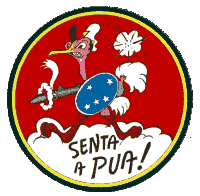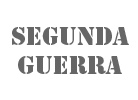

1st Brazilian Fighter Squadron in WW2
|
|
"The 1º Grupo de Aviação
de Caça (1st Brazilian Fighter Squadron – 1st BFS), consisting
of 350 crew and 43 pilots, was sent to Livorno, Italy, on October 1944,
where it became part of the 350th USAF Fighter Group. The 350th was subordinated
to the 62nd Fighter Wing, XXII Tactical Air Command, 12th USAF. At that
time, the 350th was made up of three squadrons and the 1st BFS became
its 4th squadron, operating from the Tarquinia air base. Because P-47D
Thunderbolt was the standard equipment used by the 350th , that was the
chosen aircraft to equip the 1st BFS , and not the P-51D Mustang. |
| Initially, the Brazilian P–47s were finished in standard US fighter colors, olive-drab on top surfaces over neutral gray on the undersurfaces (exception made for those aircraft of the commander and operations officer which were finished in natural metal and olive-drab anti-glare panels). The aircraft code (flight letter-aircraft number) was painted in white letters over the cowling, and the badge of the Group was painted after the engine cowling. The Badge consists of a caped and armed ostrich over a red sky (see badge figure), and was designed while the Squadron was traveling to Italy aboard the transport ship UST Colombie, by a group of its pilots. The choice of an ostrich to represent the pilots is at least curious: prior to their departure to Italy, many pilots went to the US for training. During their stay, they got acquainted to American military food: baked beans, powder eggs and powder milk, etc. When they came back to Brazil, one of their commanders called them “ostriches” because they were able to eat such “junk food”. The nickname caught. |
FAB museum of Curitiba |
Brazillian P-40E's on home defense duties |
|
|
The National insignia was initially the FAB (Brazilian Air Force) star, in four positions on the aircraft, but after a few problems of misidentification (some airplanes were shot at by allied fighters), a blue disc and bars were painted around the star, to make it similar to the USAF insignia. The original star was retained on the right wing (as can be seen in the featured model).
Although the Brazilian pilots were trained as fighters, the 1st BFS became a fighter-bomber unit in Italy, and its missions were mostly armed reconnaissance and “free-hunt” sorties, giving air support for the US 5th Army, to which the Brazilian Expeditionary Force was attached. By April, 1945, the group of pilots had been reduced to 24, some were KIA, injured and others were taken as POWs. Every pilot flew an average of 2 missions a day, and at the end of the war the group had flown 445 missions, 2,550 individual sorties and 5,465 combat flight hours.
They achieved outstanding efficacy, and between 6 to 29 April 1945, although flying only 5% of the total missions carried out by the 350th, the FBS was responsible for the destruction of 85% of the ammunition depots destroyed by the 350th, 36% of the fuel depots, 28% of the bridges, 15% of motor vehicles and 10% of horse-drawn vehicles. Such achievements rendered the 1st BFS the Presidential Unit Citation (Air Force), given by the US Government. Apart from other few USAF units, only the 1st BFS and two Royal Australian Air Force units - Nos. 2 and 13 Squadrons - have received this citation." (by Flavio da Fonseca *).
 |
"Thus, in the history of nations, has come to us the honour of being the first South American Force to cross the ocean and to raise our wings over European battlefields. Before going into action here, in the Old World, the 1st Brazilian Flighter Group fulfils its sacred duty by plating the Brazilian Flag in enemy territory. My fellow soldiers: let us go to the front, into action, with the image of the Mother Country always in our thoughts, whose honours and integrity we swore to keep safe and sound. It is our duty to face everything, with courage, in order to keep untouched that treasure which has never been violated: the honour of the Brazilian soldier! And we will do it, no matter how hard it proves to be." Maj. Nero Moura in solemm ceremony of hoisted flag. |

Brazilians waiting return to Brazil in Kelly Field(USA)
Related links
201st Fighter Squadron of Mexican Expeditionary Air Force (Pacific Campaign)
Military.com - Mexican Air Force in WW2 (in english)